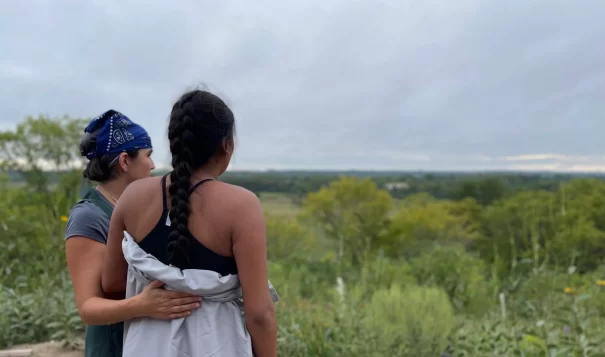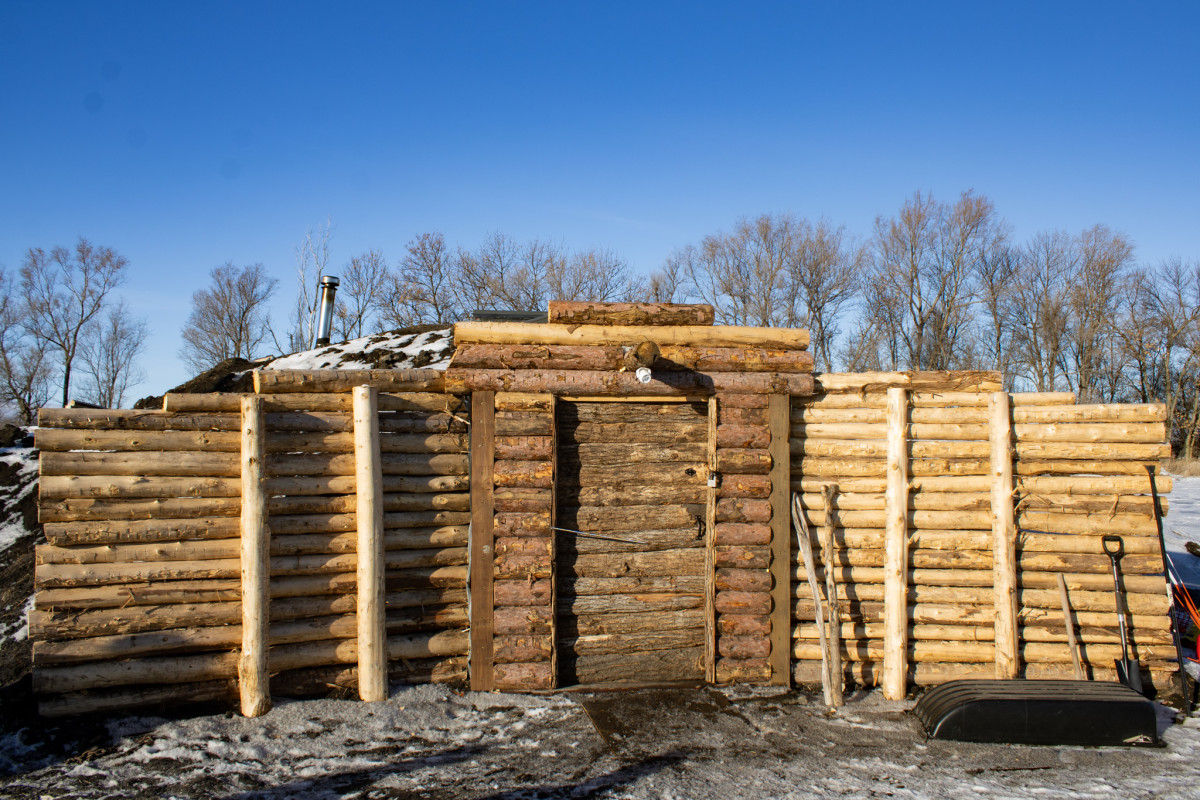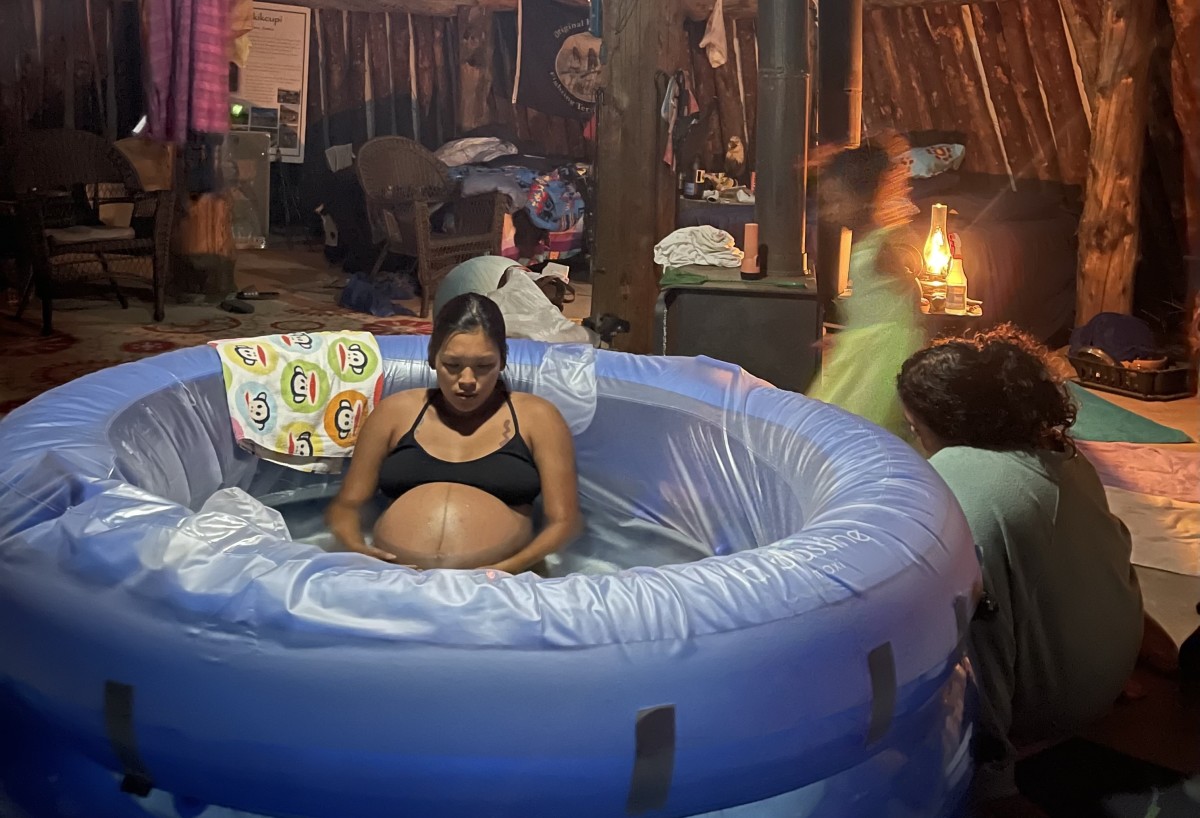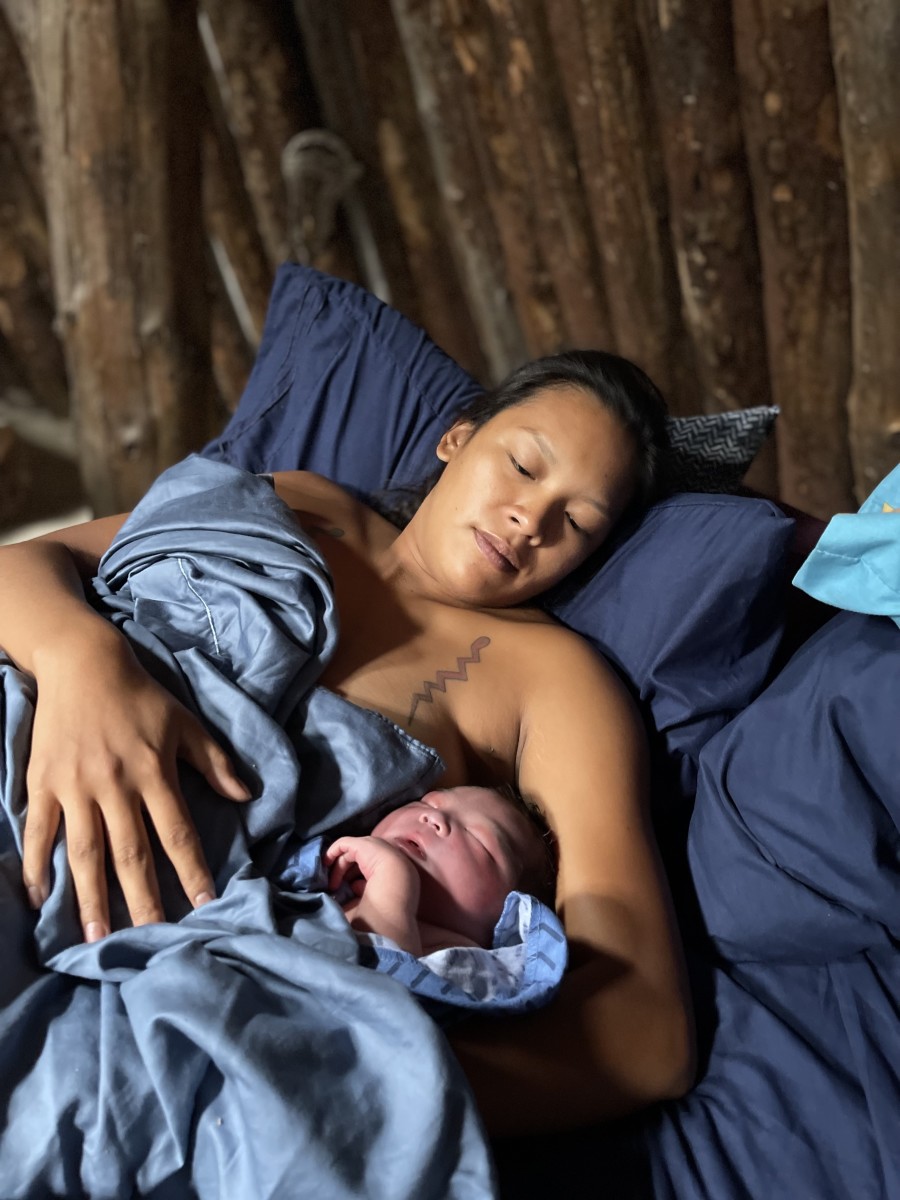News Based on facts, either observed and verified directly by the reporter, or reported and verified from knowledgeable sources.
Indigenous women reclaim traditional birthing practices
 Dallis Rencountre and her midwife Autumn Cavender-Wilson watch the sunrise after the birth of Rencountre's son. (Photo courtesy of Dallis Rencountre)
Dallis Rencountre and her midwife Autumn Cavender-Wilson watch the sunrise after the birth of Rencountre's son. (Photo courtesy of Dallis Rencountre)
As more South Dakota counties become maternal healthcare deserts, women look to alternatives. One is a traditional earth lodge
*Editor’s note: This is the second part of a two-part series on Indigenous maternal healthcare in South Dakota. The first part is available here.
For the first time in eight generations, a Dakota baby was born in a traditional earth lodge in Dakota homelands.
Under the moon of the black chokecherries, Dallis Rencountre, a citizen of the Sisseton Wahpeton Oyate, gave birth to her second child, a 10-pound baby boy. Her son was born in a traditional earth lodge in Granite Falls, Minn. built by her grandmother’s company, Makoce Ikikcupi.

“I remember sitting in the tub and thinking, ‘I don’t know if I can do this.’ I was actually very upset at my grandparents, but my grandpa looked at me and told me that the next generation is coming,” Rencountre said. “I was realizing that I was going to bring a leader to my people and that this birth was history in the making — it could be a turning point for other Dakota women to come to an earth lodge and give birth to their babies just like I did.”
It was her grandmother’s idea for her to have a traditional birth. When Rencountre was 32 weeks pregnant, her doctor at her local hospital, Coteau Des Prairies, told her she needed a cesarean section. Uncomfortable with the advice, Rencountre sought other options. She’d heard other Dakota women in her community voice similar concerns; they’d been recommended a cesarean section early in their pregnancies.
“I didn’t feel heard. I felt like he didn’t understand how I was feeling about a c-section; he wasn’t listening to me,” Rencountre said.
As hospitals across the United States close their obstetrics and gynecology departments, women in rural areas — especially Indigenous women — have fewer options for specialized care. A majority of South Dakota is considered a maternal healthcare desert, meaning there are little to no options for specialized obstetrics care across the state.

Several Indigenous women in places with no available obstetrics care, or who are unsatisfied with their care, have elected to move back to traditional birthing practices.
“There’s a time, a place and a need for medical assistance, and we have a need here in South Dakota,” said Zintkala Black Owl, Sicangu Lakota and an organizer of the He Sapa Birth Circle. “We need accessible, equipped, qualified medical facilities available for our people. We live in a really rural setting; people have to drive hours to get to a hospital.”
The He Sapa Birth Circle seeks to provide an inclusive, supportive space where Indigenous parents can share their birth experience, seek advice and receive any support they may need.
Black Owl gave birth to her seven children at home in a traditional setting. When she moved from Oregon back home to South Dakota, she found herself looking for a way to connect with other moms and provide support.
“I think that our modern culture has socialized people to fear birth and to engage with it in a medical standpoint,” Black Owl said. “We pathologize birth when really it’s a natural function of our bodies — just like breathing or blinking our eyes.”
A long history of distrust
The United States has a long history of distrust between Indigenous women and healthcare providers, specifically on reservations. A history of historical trauma can also lead Indigenous women to distrust medical providers. Forced sterilization and infant separation policies drove a wedge of distrust between physicians and Indigenous women.
From 1973 to 1976, approximately 3,406 Indigenous women were sterilized without their knowledge or through coercion by Indian Health Service practitioners — some as young as 15. In 1978, the passage of the American Indian Religious Freedom Actallowed for Indigenous people to not only openly practice traditional lifeways, but reclaim traditional birthing practices.
“I was born in 1981, to date myself, and many other people in my family and my community were born at home during that time. I think a lot of it had to do with the Religious Freedom Act and the resurgence of our people’s culture being accessible,” Black Owl said.
Decades later, Indigenous women still face barriers when seeking medical care.
In South Dakota, Indigenous women die from pregnancy-associated causes at rates four times higher than white women.
From 2012 to 2021, Indigenous women in South Dakota accounted for 46% of the pregnancy-associated deaths, despite accounting for only 9% of the state’s total population, according to the South Dakota Department of Health.
The South Dakota Department of Health noted the leading causes of death include motor vehicle accidents, mental health conditions — which includes death by suicide — substance abuse disorders and overdoses.
Nationwide, mental health conditions are the leading cause of maternal death among Indigenous mothers, according to the Centers for Disease Control. Depression is a common issue amongst Indigenous mothers, an issue that groups like the Great Plains Tribal Leaders’ Health Board hope to address.
Educating families
Traditional community-based childcare values and traditional parenting styles were lost. Many parents, especially new mothers, lack a much-needed support system post-birth. Often, new parents are left having to learn how to be a parent on their own.
“This is something we see a lot, especially in teenage moms,” said Terri Rattler, Oglala Lakota and the health board home visit program manager. “Just saying, ‘Hey, you’re doing a good job with your baby’ can do a lot.”
A community mapping assessment by the health board found 450 families in Pennington County that didn’t receive any type of home visiting services.
“I want to be the superhero, I want to get to those 450 people, but we can’t. But even if we meet with 25 to 50 families we’re still making a difference,” Rattler said.
The home visiting program utilizes the Family Spirit program to educate families on proper car seat use, baby care, general support and dealing with depression and more. Home visitors can connect families with needed resources to meet any gaps in care.
Currently, the community mapping assessment timeline consists of reaching out to existing programs and organizations, developing a community advisory group, conducting a community survey and developing a resource directory for families.
For families who survived boarding school, parenting structures were disrupted. Once home, survivors struggled to relate to their families. Once they became adults, survivors didn’t know how to be parents. They didn’t grow up with their own families or learn about themselves and their culture.
“My mom went to boarding school, living through that, I think it just makes you feel lost,” Rattler said. “I mean, she had three daughters and she wouldn’t tell us anything about our bodies; when adults were talking we’d have to go into a different room. She loved us a lot, but I didn’t really understand what she’d gone through until I was in my 40s.”
Home visitors are able to provide families with the education and reassurance needed to be a parent. In late 2023, the GPTLHB’s home visiting program received a nearly $1 million, five-year grant to provide home visits in the Rapid City area. The Rosebud Sioux Tribe, a sub-awardee, will also be able to carry out home visits on its reservation.
“Having this program is really going to help a lot of moms,” Rattler said. “Home visits can make mothers feel more comfortable in their role.”
Additionally, culturally appropriate care like those provided by the He Sapa Birth Circle and Great Plains Tribal Leaders’ Health Board can greatly benefit Indigenous mothers, babies and families, according to the Center for Disease Control. Understanding the cultural needs and practices of a patient is an important element in trust building.
Rencountre was able to give birth alongside a group of her loved ones. Her grandparents, parents, cousins, aunts and uncles were all present and assisted during the birth. Rencountre also had a trained midwife, Autumn Cavender-Wilson, present to help her through her birth.
“To anyone wanting to do this, I would just say to make sure you have a good support system and to be prepared,” Rencountre said. “[Visiting with Cavender-Wilson] it was like therapy. She let me talk about everything that was going on with my body and made me feel heard. It was the complete opposite of what I’d experienced at the hospital. She kept me going.”

After five hours of pushing, Rencountre gave birth to a 10-pound baby boy. But when her son emerged, he wasn’t breathing. Cavender-Wilson’s infant resuscitator device wasn’t working, so Rencountre watched as the midwife carefully gave the baby CPR.
“I heard the exact moment he took his first breath, his first breath of air,” Rencountre said. “She saved him.”
Rencountre’s grandfather took her baby outside and introduced him to each of the four directions and the sun. The placenta was buried outside by a tree, grounding the baby to his homelands.
“This was the best thing I’ve ever done in my life,” Rencountre said. “I love to talk about it; I hope I can inspire people to do the same thing. The whole point of me giving birth in the earth lodge was so we could have more births like that.
For those in need of support, the He Sapa Birth Circle is planning its third annual traditional birthwork gathering this fall in the Black Hills.
The Great Plains tribal home visiting program will be enrolling families for home visits sometime in the fall within the next six months, once the community needs and readiness assessment mapping process is completed. The home visiting program will be enrolling expecting parents, mothers, fathers, caregivers and children 0 to 5 years of age.
